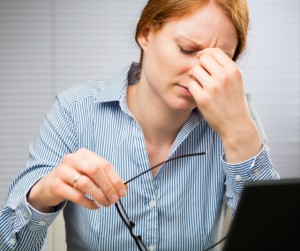Posted by: Atlantic Eye Institute in Education

A blepharospasm is a repetitive, uncontrollable blink or spasm of the eyelid. This condition can be caused by any of the following reasons:
- Stress: Stress can manifest itself differently for each person. If you have frequent eye spasms keep track of when they occur. If they occur at times when you experience stress try to find ways to help you relax.
- Fatigue: A lack of sleep can cause your entire body to feel stress and can trigger a twitching eyelid. Catching up on sleep can help.
- Eye strain: Vision-related stress can occur if you need glasses or have recently changed your glasses. Your eyes may be working too hard which can trigger eyelid twitching. Computer eye strain from overuse of computers, tablets, and smartphones is also a very common cause of vision-related stress. Looking away from up-close work for 20 seconds every half hour can help.
- Eye irritation: If your eyes are irritated for any reason you may notice your lid twitching.
Caffeine and alcohol: Too much caffeine or alcohol can trigger eye twitching. If your intake of either has increased, cutting back may help. - Dry eyes: If you have dry eyes causing irritation of the cornea or conjunctiva, treating it with over-the-counter artificial tears will often relieve minor eyelid twitch.
- Nutritional imbalances: A lack of certain nutritional substances can trigger eyelid spasms. Be sure to eat balanced, healthy meals!
- Allergies: People with eye allergies can have itching, swelling, and watery eyes. When eyes are rubbed, histamine is released into the lid tissues and the tears. There is some evidence that indicates histamine can cause eyelid twitching.
- Side effects of medication: Some medications can have a side effect of eye spasms.
In most cases, minor eyelid twitches will disappear on its own. Getting enough rest by going to bed 30 minutes to an hour earlier can help ease the strain on the eyelids and reduce your spasms. Decreasing or eliminating your intake of alcohol, tobacco, or caffeine is another effective method to help get rid of blepharospasms. If you are experiencing increasingly frequent episodes of eyelid spasms, keep a journal and note when they occur.
Eyelid twitches are rarely serious enough to require emergency medical treatment. However, chronic eyelid spasms may be a symptom of a more serious brain or nervous system disorder. You may need to see your doctor at Atlantic Eye Institute if you are experiencing chronic eyelid spasms and/or exhibit any of the following symptoms:
- Your eye is red, swollen, or has an unusual discharge.
- Your upper eyelid is drooping.
- Your eyelid completely closes each time your eyelids twitch.
- The twitching continues for several weeks.
- The twitching begins affecting other parts of your face.
The most commonly recommended medical treatment for blepharospasm is Botox. Most people think of Botox as a solution for facial wrinkles, however, as Botox temporarily paralyzes the muscle it is injected into, it works as a great remedy for blepharospasms as well. Botox is injected in very small quantities into the muscles surrounding the eye. This may relieve spasms for several months, but the effects gradually wear off and repeat injections are usually necessary. Most medical insurances will cover the Botox treatment for blepharospasms as it is a medical condition rather than a cosmetic procedure for wrinkles. If you are interested in scheduling a consultation for a Botox treatment or wish to find out more, please give us a call at 1-888-795-2020.



